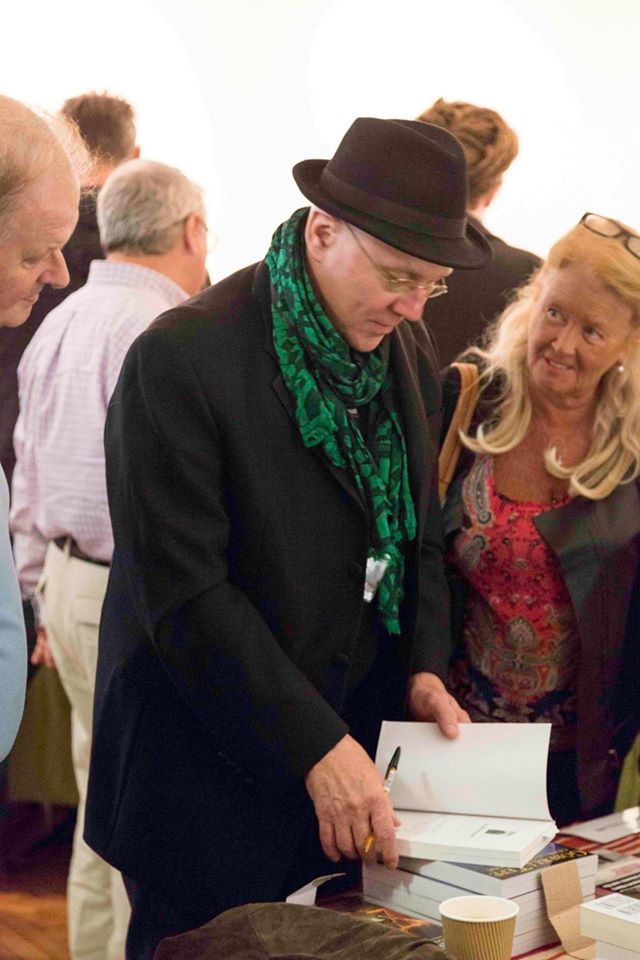
Andrew Collins at Origins 2017 (pic credit: Alvin Krishan Askoolum)
E
A R T H Q U E StTT N
E W S

Andrew
Collins at Origins 2017 (pic credit: Alvin Krishan Askoolum)
ANDREW
COLLINS NEWSLETTER - DECEMBER 2017
In
this issue: Update on new book The Cygnus Key. The latest on Tabby's
Star. Plus Gobekli Tepe is the Garden of Eden new documentary claims (is it? yawn),
while another says it is a pagan shrine smashed up by Abraham! Read also about
the 8,600 year old bear statuette found at a mound complex in Turkey and the discovery
of a 30,000-year-old settlement in Brazil.
Hi, hope this e-newsletter
finds you well. I want to thank everyone who attended the Origins 2017 event in
London on November 4/5. The event was a complete sell out, and other than a few
technical problems at the beginning of the day everything went off perfectly.
The Sunday at the British Museum was great also.
I want to welcome all
those who attended an Origins event for the first time this year. I trust you
had a good time. I have added your email address to the mailing list for these
newseltter updates. If you do not wish to receive them, simply press the "unsubscribe"
box at the base of the page.
What I think was most warming about the response
to the event was the fact that people seemed to like the blend of speakers, and
the fact that as an audience they had the chance to hear authors speak whose books
they had read in the past. Likewise, the speakers themselves seemed to appreciate
the event as can be seen from the following kind words said afterwards by Michael
Cremo:
"As for my experience with Origins 2017, I found it to be,
from a speaker's point of view, a model example of what a conference should be.
Every commitment made by the organizers was kept ... All this was done very punctually
and efficiently. Just amazing. And what to speak of all the unexpected delights
of meeting you all, the post conference dinner, etc. I am truly grateful to you
all for putting together such a wonderful event."
Thank you, Michael.
Oh, well, let's see what happens in 2018!!
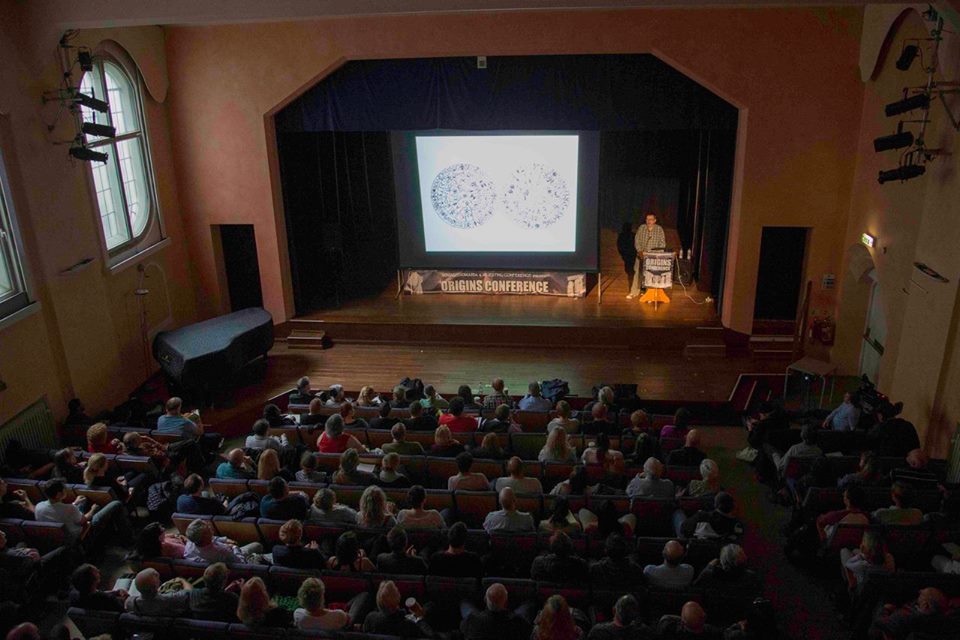
Alan
Butler on stage at Origins 2017 (pic credit: Alvin Krishan Askoolum).
See all the pictures from Origins 2017 at the following link:
https://www.facebook.com/pg/OriginsConferenceLondon/photos/?tab=album&album_id=1170017366464432
TABBY'S STAR UPDATE
On the Saturday evening
of Origins 2017 I gave a brief talk on Tabby's Star, alias KIC 8462852 or the
alien megastructure star, revealing the strange mathematical patterns emerging
from its periodic light fluctuations, and what this might mean for the future.
I then conducted a coordinated visualisation with the audience of over 200
focusing on the star in order to initiate a thought experiment, one in which the
star might be seen to respond in some manner (whether coincidence or not, it had
worked twice in the fast).
What those who participated in the event want
to know is whether anything happened to Tabby's Star around the time of the visualisation.
The answer, I have to admit, is no, although from around September 14 this year
through until November 15-17 the star's light emissions had been increasing in
a manner not monitered before on a daily basis.
Since that time the light
has been very slowly decreasing again. I have included below a graph of the rise
in light emissions from Tabby's Star starting in August and peaking around a week
or so. This comes from engineer Fredric Parker and is based on data supplied by
Arizona astronomer Bruce Gary. It shows a Gaussian curve neatly overlaid on data
points. If the trend continues it means that the light emissions will return to
normal soon.
As to what caused this sudden increase in light over the
last two months remains a matter of conjecture. Some might say it is the result
of dust clouds clearing temporarily, while others are now suggesting it reveals
the presence of a second object in close contact with the main sequence star.
This second object has just come into view from around the back of the star, and
is either reflecting stellar light or is emitting it itself. As to what this second
object might be is again open to speculation. It is suggested it could be a brown
dwarf on a 1600-day cycle.
A brown dwarf is an intermediate object between
a small star (known as a red dwarf) and an extremely large Jupiter like planet.
This said, a binary object of this sort could be anything, maybe even a Death
Star! Whatever the answer, as Fredric Parker says itself, it must be truly massive
in size.
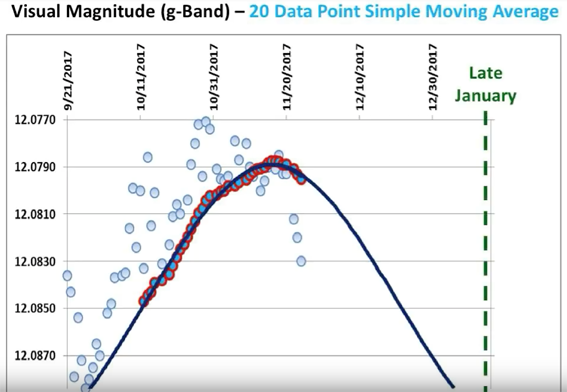
The graph is taken from Fredric Parker's latest video on Tabby's Star, which
can be accessed at the following link: https://www.youtube.com/watch?v=BRHxO4LZmqk
THE CYGNUS KEY
The week before the
conference I received the edited version of my book The Cygnus Key from publishers
Inner Traditions. This I have to read through line by line at least three times,
and answer all of the editor's 125 odd queries. I also have to make any corrections,
changes or additions in readiness for the book going off to production.
As
you can imagine, receiving this just before the rigours of the conference was
not helpful to me, although I kept my wits, tried not to stress, and attempted
to read the manuscript inbetween preparing for both the conference and the Sunday
walkabout around the British Museum. On returning to Essex after the conference
I got immediately on to continuing the editing, which I managed to finish last
week.
The entire book is much better for the edit. I have managed to add
more material on the Denisovans, which was the subject of my main lecture at Origins.
I think you will find that everything you need to know about their lost legacy
is now contained in the book, from their discovery in 2008, to their habitat,
their physical appearance, their achievements, the myths connected with them,
and what exactly the legacy was they left to our own human ancestors. I will this
continued to exist filtering through to Gobekli Tepe in Anatolia by 9600 BC and
from here going into Egypt, where it would eventually inspire the construction
of the three main pyramids of Giza.
The bottom line is that the Denisovans,
through their legacy, can be seen as the founders of our own civilization in southern
Siberia around 45,000 years ago. They are also the best evidence we have for the
remnants of a lost civilization that we are only now beginning to understand for
the first time.
The only downside of updating The Cygnus Key is that I
have had to retire some of its existing content, including two chapters on the
impact of Gobekli Tepe's Pre-Pottery Neolithic on the Greek Hellenic cults of
Bacchus-Dionysus and Orpheus. They followed a chapter where I explored the importance
of the symbol of the panther-leopard at Gobekli Tepe and Catalhoyuk in southern
central Anatolia. This chapter still remains, although I have expanded it to include
a precis of what was in the retired chapters (7 & 8).
As a festive
gift to you I attach a PDF containing the two lost chapters of The Cygnus Key.
Read them at your leisure. I think you will find them of considerable interest,
especially the fact that the origins of wine and beer production can both be traced
back to southeast Anatolia, the very area of Pre-Pottery Neolithic sites like
Gobekli Tepe and Cayonu. I am certain that alcohol fuelled rites among the Pre-Pottery
Neolithic peoples of southeast Anatolia went on to influence the cults of Cybele
and Bacchus-Dionysus, which both flowered in Asia Minor (moderm Asiatic Turkey).
Despite two chapters being retired, others expanded, and in actuality the
book has exactly 41 chapters - the number being carefully chosen as this is an
important "complex number" to the shamans and seers of the Tuvan republic
in southern Siberia.
Why 41? You'll find out when you read the book!
Order your copy now!
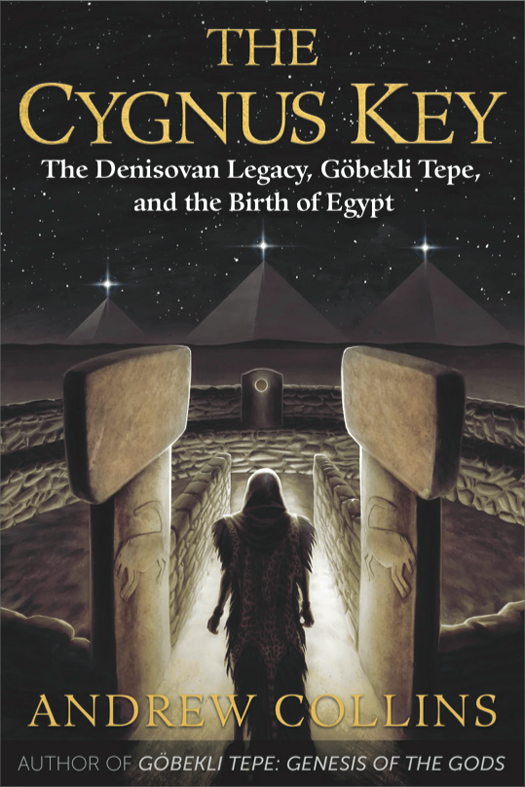
The
cover of The Cygnus Key: The Denisovan Legacy, Gobekli Tepe and the Birth
of Egypt.
Pre-order your copy now from Amazon:
https://www.amazon.com/Cygnus-Key-Denisovan-Legacy-Göbekli/dp/1591432995/ref=sr_1_1?ie=UTF8&qid=1504033688&sr=8-1&keywords=the%2Bcygnus%2Bkey
Go also to Barnes and Noble where they have a few mock ups of the books interior:
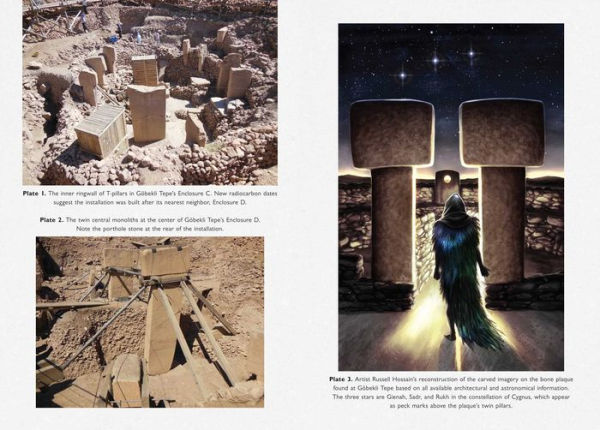
Pre-order your copy now from Barnes & Noble at the following link:
https://www.barnesandnoble.com/w/the-cygnus-key-andrew-collins/1126791696?ean=9781591432999
THE NEW, NEW BOOK!
Even though The Cygnus
Key wont be out until next year, I have just two months to finish the other book
I have been working on now for around six years.
It shows the influences
that came to bear on the emergence of Gobekli Tepe, and how they also became the
first Americans.
It is a project I am working on with Dr Greg Little,
one of the United States leading experts on the earliest migrations into the Americas
and also of the mound-building cultures like the Adena and the Hopewell.
To
put it simply, Greg is doing the American genesis and I am doing the same thing
for the Eurasian continent. The Denisovans will be involved again, of course,
although this book will take a slightly different course to The Cygnus Key. As
with all my other books, it will include the latest updates on the situation at
Gobekli Tepe, including any new discoveries.
So if you don't hear from
me until after January. Don't worry. I haven't gone away. Not quite yet!
GOBEKLI TEPE IS A PAGAN SHRINE! BUT MAYBE REDEEMED BY ABRAHAM!
Here's one that will surprise the German archaeologists trying to work
at Gobekli Tepe amid the construction machinery and mayhem caused by the placing
of two massive roofs over sections of the site. The Turkish Government have sponsored
a new TV documentary claiming that the site was the creation of the prophet Abraham's
father Aser (biblical Terah).
This is a story based on a Qu'ranic and
Jewish story telling how Abraham (Arabic Ibrahim) smashed up the idols of the
pagan shrine built by his father Terah in his home city of Ur of the Chaldees,
traditionally identified with Sanliurfa.
The pillars and carved relief
at Gobekli Tepe are being seen as those idols. I wouldn't normally promote sceptic
Jason Colavito's blogs as they very often attack the likes of myself, but this
one is quite fair.
Yet Colavito points out something that occurred to
me as well, and this is the fact that the Turkish government is becoming increasingly
more Islamised, and thus sees fit to see things either in terms of Qu'ranic tradition
or as pagan idolatry.
Here at Gobekli Tepe, close to Sanliurfa, where
Isil cells unfortunately now operate, it seems the Turkish government are edging
their bits - seeing the site as both a pagan shrine and as somewhere redeemed
by Abraham, who is traditionally believed to have been born in Sanliurfa.
This is a blessing, as otherwise Gobekli Tepe is not going to last very long
at all under the current political climate (it has already been closed now to
the public for well over a year and a half, and this is NOT simply because of
the new roof being built).
Here is Jason Colavito's blog on the subject:
http://www.jasoncolavito.com/blog/turkish-government-funds-documentary-claiming-gobekli-tepe-was-built-by-abrahams-father-and-destroyed-by-abraham
Here is the original story in Turkey's Hurriyet News:
http://www.hurriyetdailynews.com/documentary-depicts-ancient-gobeklitepe-as-idol-center-from-abrahamic-age-108168
* NEWS FLASH - GOBEKLI TEPE IS THE GARDEN OF EDEN
- END NEWS FLASH *
A recent Channel 5 documentary focused on Gobekli
Tepe claiming that its existence in southeast Turkey and the spread of civilization
from the same region is recalled in the monotheistic concept of the Garden of
Eden.
Here is the link to a review of the documentary in The Guardian:
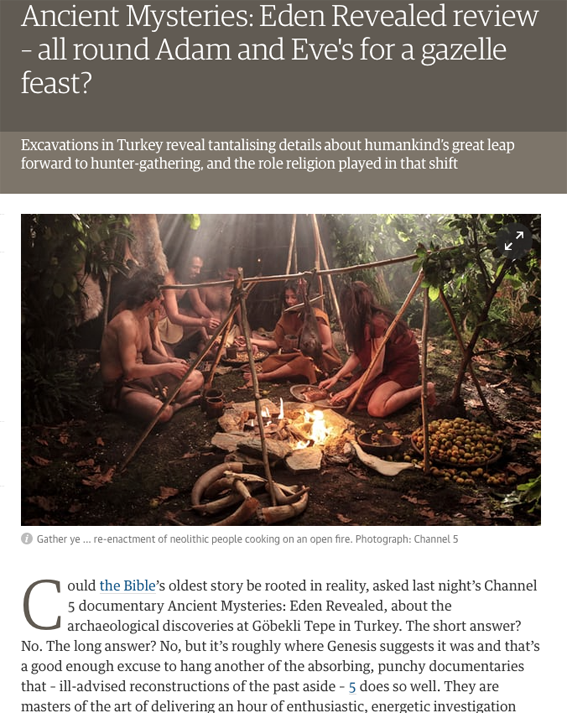
https://www.theguardian.com/tv-and-radio/2017/nov/25/ancient-mysteries-eden-revealed-review-adam-and-eve-gazelle-feast
All that's fine, and I am glad that mainstream media and some alternative
historians and archaeologists are waking up to this fact. However, having come
this far I would like to introduce them to my books:
From
the Ashes of Angels (1996)
God of Eden (1998)
Gobekli Tepe:
Genesis of the Gods (2014)
All of these books build a strong,
consistent case to show that the emergence of southeast Anatolia's Pre-Pottery
Neolithic world was responsible for catalysing the Neolithic revolution, which
is recalled in the story of Adam and Eve in the Garden of Eden and the stories
of the fallen Watchers of the book of Enoch (the Anunnaki of Sumerian tradition)
providing humanity with the rudiments of civilization.
At the end of the
day, I am just happy that what I write is on the right track, even if it is completely
ignored by all but a few. P. S. Thank you at least for reading my books, and taking
me seriously!
BRAZIL FIND DATES PUSH DAY FIRST AMERICANS
TO 30,000 YEARS AGO
Evidence emerging from Brazil's Mato Grosso
of the discovery of a human campsite going back 30,000 years. Archaeologists have
found evidence of hearths and tools made from stone and the bones of giant sloths.
Over 300 chipped stone tools were found with clear evidence of serration and
retouching, which can only be of human creation.
The excavations took
place at Santa Elina, 80 km from Cuiabá under the leadership of Denis Vialu,
and Águeda Vega Vialu of the National Museum of Natural History of France.
The site has been dated using three different methods including carbon-14
and optical luminescence. This has provided a minimum age for the campsite of
27,000 years.
It is important to recall that North American archaeologists
are reluctant to accept any human activity in the Americas earlier than around
15,000-20,000 years.
The archaeologists involved in the excavations suggest
that the earliest peoples to arrive in Brazil might have come from Africa.
Intriguingly, they talk about ocean currents that would have taken voyagers
from Africa across to Brazil and the Caribbean.
Although the oldest official
evidence of human activity in the Caribbean is no more than 8000 years old, I
propose in "Atlantis in the Caribbean" that the archipelago was occupied
at least by the time of the Younger Dryas event, ca. 10,800-9600 BC.
The
news story is in Portuguese:

https://noticias.uol.com.br/ciencia/ultimas-noticias/bbc/2017/11/26/descoberta-brasileira-aumenta-a-discussao-quando-a-humanidade-chegou-as-americas.htm
A rough translation into English is given at the bottom of this e-newsletter.
8,600-YEAR OLD BEAR STATUETTE FOUND AT NEOLITHIC
MOUND SETTLEMENT IN TURKEY
An 8,600-year-old bear statuette has
been found during excavations at a Neolithic site near Izmir in Turkey.
The
baked clay object comes from the Yesilova Mound, which is contemporary to the
more well known urban centre of catalhoyuk on the Konya Plain in central southern
Turkey.
Here is the original story:

https://www.dailysabah.com/history/2017/10/22/8600-year-old-bear-statuette-unearthed-in-turkeys-izmir
EGYPT TOUR - ROOM STILL AVAILABLE
Still
time to come with Hugh Newman, Brien Foerster and myself to Egypy on our grand
tour planned for March 2018.
We have over 20 people going so far, so there
is no question that this event will go ahead.
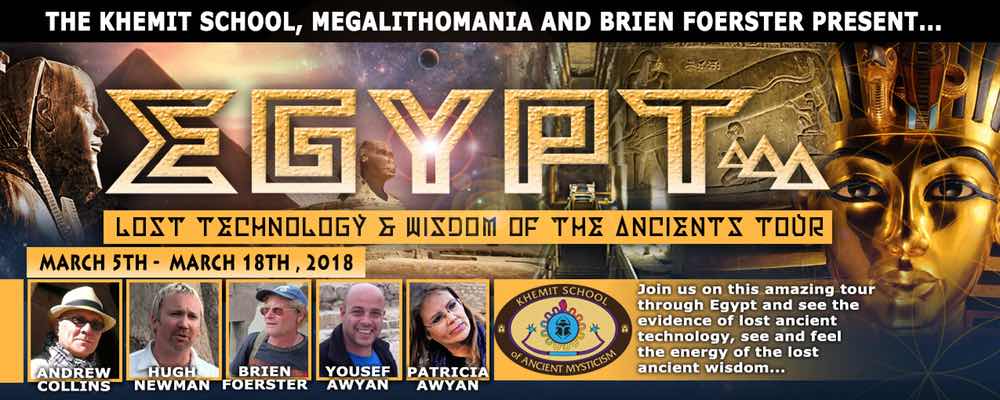
Visit
Egypt in March 2018 with myself, Brien Foerster, Hugh Newman, Patricia Awyan,
Yousef Awyan, and the Khemit School.
Click
below for full details and immediate registration.
https://hiddenincatours.com/shop/tours/major-tours/march-2018-egypt-tour/
Brazilian discovery
increases the discussion
When mankind arrived in the Americas?
Sen
da Silveira-De São Paulo for BBC Brazil BBC Brasil, in São Paulo
26/11/201706h34
Stone tools, bonfires and adornments Recém-encontrados
in Mato Grosso and dated almost 30000 years have given fuel to a historical discussion
in modern archaeology: the date of arrival of humans in the Americas.
There
are different theories, from those who claim that the event occurred about 12000
years ago even those who bet on 100,000 years or more.
The recent discovery
was made in the archaeological site of Santa Elina, 80 km from Cuiabá.
The archaeologists responsible for excavations, Denis Vialu, and Águeda
Vega Vialu, the National Museum of Natural History of France, affirm that this
Brazilian region has been inhabited for at least 27000 years.
"A
proof is the presence of more than 300 objects of chipped stone, with serrated
and retouching, which could only have been made by the hand of man," says
Águeda, which carries excavations in the Serra das Macaws since 1995.
Another
evidence of human presence, according to her, is remnants of bonfires.
'
Triple rarity '
The
material found was dated by three different methods, involving from carbon to
14 to optical luminescence.
According to Águeda, the site of Santa
Elina brings a triple rarity: "The first is that human occupations Pleistocênicas
(between 2,588,000 and 11700 years ago) are rare and for while there is the only
site discovered in the center of the South American continent."
The second
and third rarities relate to the adornments found: some were made with bones of
giant sloths of the genus Glossotherium, already extinct.
"It is
the first case in Brazil of a perfect association of man with the extinct megafauna,"
she explains. "There are the manufacture of symbolic objects with megafauna
bones, turning them into adornments."
Discussion since Columbus
The
discussion on the date of arrival of humanity in the Americas refers to the times
of Christopher Columbus, when he landed in the Caribbean on October 12, 1492.
He was greeted by the Tainos people, a friendly people, that the Genoese navigator
in service of Spain thought they were Indians, because he was convinced he had
reached India-and remained with that conviction until death.
The discoverer
of America did not know, but its arrival in the continent has indeed marked the
reunion of two evolutionary lineages of Homo sapiens, which were separated at
least 50000 years ago: its own, European, and the first American, Mongoloides,
related to the Asian peoples.
Since
then, the mystery persists: how and when the peoples found by Columbus have arrived
in the Americas?
Theories are not missing. The oldest and toughest is
the model known in English as Clovis-first (Clovis-1st). It owes its name to a
so-called archaeological site, discovered in 1939, in New Mexico, United States.
On site, chipped stone artifacts were found, dated 11400 years ago. According
to this theory, advocated primarily by the American archaeological community,
the arrival would have occurred about 12000 years ago.
The so-called "three
migration Model", suggested in 1983 by Christy Turner, is based on a broad
survey of dental diversity, which concluded that there were three migratory leads
from Siberia to America.
The first, 11000 years ago, would have originated
all the Indians from Central and South America and the majority of Native American
peoples. The second would have arrived 9000 years ago and originated the ancestral
Indians from the Apaches and Navajos, especially in the Pacific coast of the United
States and Canada. The latter would be much newer, 4000 years ago, and composed
by the ancestors of the Eskimos and Peoples Aleutian (in the Arctic Circle).
Brazilian theories
Brazilian
scientists also have their theories of occupation of the Americas.
One
was developed by biologist and anthropologist Walter Alves Neves and by the geographer
Luís Beethoven Jatan Patel, both of the University of São Paulo
(USP). They propose that the first Americans reached the mainland in two migratory
leads, the first for 14000 years and the second there are 11000, coming from Asia
by the Bering Strait.
According to them, the first lead would be composed
of a population with traits similar to those of Africans and Aboriginal Australians.
The second era of mongoloides, similar to the current Asian and American Indians.
A
second theory was proposed by three Brazilian geneticists and an Argentine anthropologist,
defending that there was only one migratory lead, 18000 years ago.
Prior
to that, the ancestors of migrants had been "trapped" in the Beríngia,
region that United Alaskans northeast of Siberia and that at that time was not
underwater (it was the apex of the last glacial period and the sea was 120 meters
below the current level).
"This
population has sheltered from types similar to Africans to the present-day Indians,"
explains Maria Cátira Bortolini, the Federal University of Rio Grande do
Sul, a member of the group.
There's still a third theory about the occupation
of America. Much more controversy, she was proposed by the archaeologist Niéde
Guidon, based on her findings in various archaeological sites in southern Piauí.
For her, the man came to the region nothing less than 100,000 years ago, coming
directly from Africa, crossing the Atlantic, at a time when the planet was also
in an icy period, with the sea 120 meters below its current level.
"With
this, the number of islands between the euro-African coast and the South American
coast was much larger," he says. "Moreover, the maritime currents favourits
passage to the east, to the Caribbean and to the north coast of Brazil."
Controversy
It
is in this context that the discovery of the vial or increase the controversy.
Some Brazilian researchers see it with caution and others, as the confirmation
that humans have reached the mainland long before they propose some theories.
"Authors are archaeologists with excellent training, so their publications
should be taken into consideration," says Guido. "All findings are important
in archaeology, because traces are usually under the earth and can disappear over
the years."
O
geneticista Fabrício Santos, da Universidade Federal de Minas Gerais (UFMG),
outro membro do grupo que propôs a teoria de uma leva só de migrantes,
é mais cauteloso.
"It's another place with old dates,"
he says. "It seems to be well dated, but it has no human bones, only two
punctured utensils. It opens up perspective that the occupation of South America
may be older, but more evidence is lacking with several human remains and also
bones. "
In what everyone agrees is that the model Clovis-first is outdated
because of a series of discoveries in recent decades.
"The idea that
Clovis culture would have been the first to emerge in America was definitively
discarded due to the undeniable antiquity of the Mount Verde site in Chile, 12500
years ago, says researcher Francisco Mauro Salzano, the Department of Genetics
of the Institute of The Federal University of Rio Grande do Sul (UFRS).
"Moreover,
a series of other dates in South and North America served as a strengthening of
the abandonment of this theory, including an arrowhead found buried in the rib
of a mastodon, on site Manis, Washington, USA, dated 13800 years ago."
FESTIVE GREETINGS TO YOU
FROM ME ANDREW COLLINS!
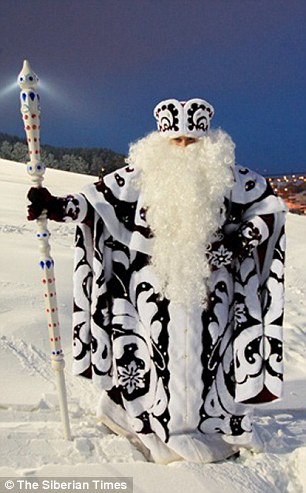
Siberian
Father Christmas shaman! Well, maybe.